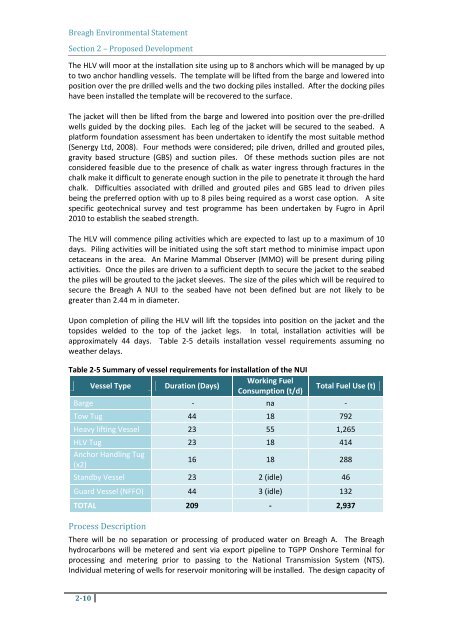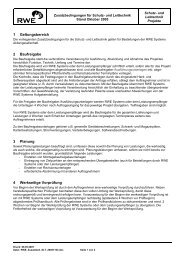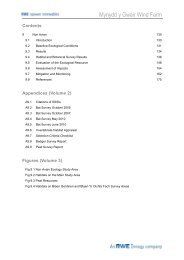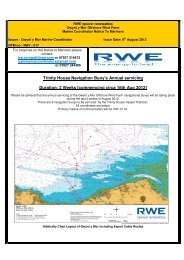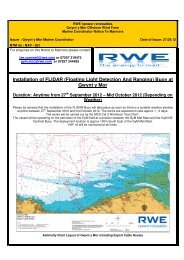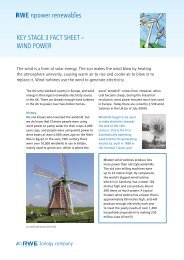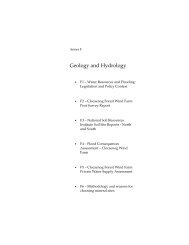Breagh Development - RWE.com
Breagh Development - RWE.com
Breagh Development - RWE.com
You also want an ePaper? Increase the reach of your titles
YUMPU automatically turns print PDFs into web optimized ePapers that Google loves.
<strong>Breagh</strong> Environmental Statement<br />
Section 2 – Proposed <strong>Development</strong><br />
The HLV will moor at the installation site using up to 8 anchors which will be managed by up<br />
to two anchor handling vessels. The template will be lifted from the barge and lowered into<br />
position over the pre drilled wells and the two docking piles installed. After the docking piles<br />
have been installed the template will be recovered to the surface.<br />
The jacket will then be lifted from the barge and lowered into position over the pre-drilled<br />
wells guided by the docking piles. Each leg of the jacket will be secured to the seabed. A<br />
platform foundation assessment has been undertaken to identify the most suitable method<br />
(Senergy Ltd, 2008). Four methods were considered; pile driven, drilled and grouted piles,<br />
gravity based structure (GBS) and suction piles. Of these methods suction piles are not<br />
considered feasible due to the presence of chalk as water ingress through fractures in the<br />
chalk make it difficult to generate enough suction in the pile to penetrate it through the hard<br />
chalk. Difficulties associated with drilled and grouted piles and GBS lead to driven piles<br />
being the preferred option with up to 8 piles being required as a worst case option. A site<br />
specific geotechnical survey and test programme has been undertaken by Fugro in April<br />
2010 to establish the seabed strength.<br />
The HLV will <strong>com</strong>mence piling activities which are expected to last up to a maximum of 10<br />
days. Piling activities will be initiated using the soft start method to minimise impact upon<br />
cetaceans in the area. An Marine Mammal Observer (MMO) will be present during piling<br />
activities. Once the piles are driven to a sufficient depth to secure the jacket to the seabed<br />
the piles will be grouted to the jacket sleeves. The size of the piles which will be required to<br />
secure the <strong>Breagh</strong> A NUI to the seabed have not been defined but are not likely to be<br />
greater than 2.44 m in diameter.<br />
Upon <strong>com</strong>pletion of piling the HLV will lift the topsides into position on the jacket and the<br />
topsides welded to the top of the jacket legs. In total, installation activities will be<br />
approximately 44 days. Table 2-5 details installation vessel requirements assuming no<br />
weather delays.<br />
Table 2-5 Summary of vessel requirements for installation of the NUI<br />
Vessel Type Duration (Days)<br />
Working Fuel<br />
Consumption (t/d)<br />
Total Fuel Use (t)<br />
Barge - na -<br />
Tow Tug 44 18 792<br />
Heavy lifting Vessel 23 55 1,265<br />
HLV Tug 23 18 414<br />
Anchor Handling Tug<br />
(x2)<br />
16 18 288<br />
Standby Vessel 23 2 (idle) 46<br />
Guard Vessel (NFFO) 44 3 (idle) 132<br />
TOTAL 209 - 2,937<br />
Process Description<br />
There will be no separation or processing of produced water on <strong>Breagh</strong> A. The <strong>Breagh</strong><br />
hydrocarbons will be metered and sent via export pipeline to TGPP Onshore Terminal for<br />
processing and metering prior to passing to the National Transmission System (NTS).<br />
Individual metering of wells for reservoir monitoring will be installed. The design capacity of<br />
2-10


